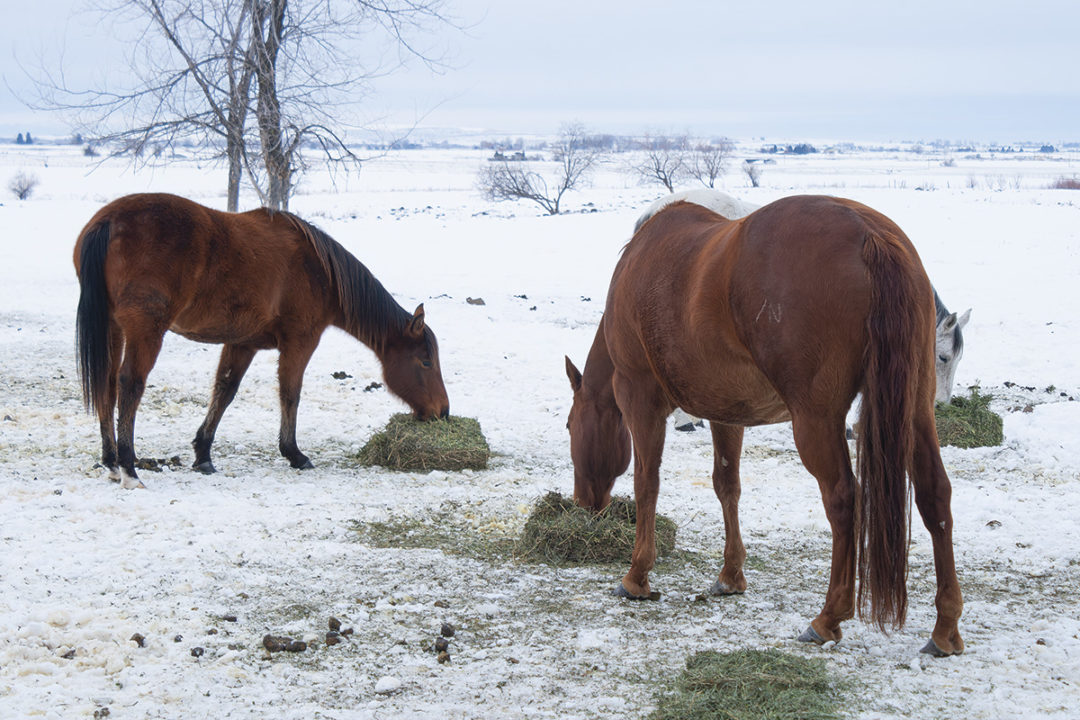Hay is the bulk of horse diets. Therefore, it is critical to utilize and understand an analysis. Interpreting your report will help determine which supplemental feeds to incorporate into your horses' diet. So here are five nutritional factors to examine on a hay analysis for horses:
1. Moisture
First, always ensure that the moisture is less than or equal to 15% to avoid mold issues. High-moisture environments foster the growth of mold. If hay is more than 15% moisture, horses should be monitored for respiratory symptoms. Coughing, sneezing and runny nose will be the first signs that mold may be an issue.
2. Protein
Second, look at the protein level of the forage compared to your horse’s protein requirement. Protein requirement can be calculated for maintenance using the equation:
Crude protein (pounds/day) = bodyweight (pounds) × 0.001441
Calculating the pounds per day, however, does not help to compare to a forage report expressed in percent dry basis. So, to estimate the intake, multiply by the estimated intake as a percentage of bodyweight. In Figure 1, I used 1.8% because it is a grass hay. Grass hay intake can vary from 1.5%-2% of bodyweight, and alfalfa can vary from 2%-2.5% of bodyweight. Divide the protein requirement per day by the intake per day to calculate the percentage of the total diet per day. The units are now in percent and can be compared to a forage report.

In Figure 1, the distribution of 54 grass samples analyzed with NIRS Forage and Feed Testing Consortium calibrations for horse consumption was contrasted with the requirement of a 1,200-pound horse at maintenance and with a heavy workload. You can assume other work level requirements fall between these two lines. Based on this subset of samples, most hay submitted for horses does meet or exceed their protein requirement.
3. Digestible energy
Third, compare digestible energy (DE) requirements of your horse to what is provided by the forage. Like protein, some calculations will be required. To calculate the DE requirement for maintenance, the following equation can be used:
DE (Mcal/day) = 1.4+(0.01361 × bodyweight [pounds])
Again, Mcal per day does not compare requirements to the hay analysis. So, divide the DE by the expected pounds-per-day intake. The resulting units are Mcal per pound and can be used to compare requirements to the forage report. Figure 1 shows that grass hay for horses is more variable in its ability to meet energy requirements. Most hay will be adequate for maintenance, but will require grain supplements as workload increases.
4. Fibers
Next, understanding the fibrous portion of the hay is also key. Acid detergent fiber (ADF) and amylase-treated neutral detergent fiber (aNDF) are important in the horse’s diet because horses are hindgut fermenters. The ADF is the most digestible portion of the forage, and the aNDF is the least digestible. Microbes in the horse’s cecum degrade these carbohydrates and produce volatile fatty acids, which are the absorbed nutrients. Balanced fiber intake is important to maintaining a healthy digestive tract. Equine nutritionists typically recommend ADF to be less than or equal to 45% dry basis and NDF to be less than or equal to 65% dry basis.
5. Non-structural carbohydrates
Finally, non-structural carbohydrates (NSC) should be considered for horses with metabolic issues including equine diabetes, laminitis or sometimes “easy keepers.” The general guideline is to keep this value below 10% dry basis. This is another value that requires calculation:
NSC = starch (% dry basis) + water-soluble carbohydrates (% dry basis)
Figure 1 shows that most hays in our analysis were higher in NSC than recommended for metabolic syndrome horses. It should be noted that there is no guideline for active healthy horses regarding NSC content of the hay.
In conclusion, most hay analyzed to be fed to horses meets or exceeds protein requirements. There is clearly a need to supplement energy, which is why most horse owners supplement forage diets with grain. Metabolic syndrome horses are supposed to avoid having grain energy supplementation in their diet. According to these laboratory samples, finding hay low in NSC with adequate energy for horses with metabolic issues may be a challenge. Further, few samples had been identified for horses. So there is opportunity for horse owners to use hay analysis as a tool to improve their horses' nutrition.










